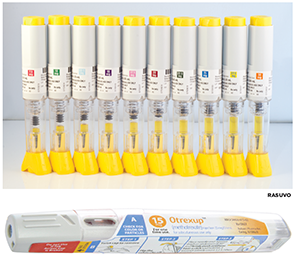
Image Credit: Bottom: antares pharma inc./ Top: medac pharma Inc.
Methotrexate has long been a cornerstone of therapy in rheumatoid arthritis. Two new, injectable methotrexate products may help some RA patients for whom oral methotrexate is not as effective or causes adverse effects.
Rasuvo and Otrexup are prefilled, auto-injection devices that allow patients to give themselves subcutaneous injections of methotrexate without having to use a separate syringe and vial. Benefits of these new products include convenience and ease, but the drawback is a much higher cost.
Rasuvo is a single-dose auto-injection device that comes in 10 different doses of methotrexate: 7.5, 10, 12.5, 15, 17.5, 20, 22.5, 27.5, and 30 mg. Otrexup is available in doses of 10, 15, 20 or 25 mg per 4 mL.
Oral’s Drawbacks
Typically, RA patients take 15 mg of oral methotrexate each week, although some need a lower or higher dose, says Bella Fradlis, MD, attending physician, Division of Rheumatology, at Montefiore Health System and Assistant Professor at Albert Einstein College of Medicine in New York.
“The oral preparation of methotrexate seems to be the ‘go-to’ given cost-effectiveness and convenient dosing,” she says. “However, not all patients are able to tolerate oral methotrexate equally well. Some patients experience gastrointestinal side effects, such as nausea or vomiting.”
Bioavailability of oral methotrexate may be only two-thirds of what is absorbed when the drug is injected subcutaneously.
Stomach problems are not the only possible drawback of oral methotrexate. “You don’t get as much effective absorption with oral methotrexate” as can be achieved with subcutaneous injection of the drug, says Jonathan S. Coblyn, MD, Director of the Center for Arthritis and Joint Diseases at Brigham and Women’s Hospital in Boston. “The reason we may go to injectable methotrexate is that you may lose potency as you increase the dose.”

Dr. Fradlis
Bioavailability of oral methotrexate may be only two-thirds of what is absorbed when the drug is injected subcutaneously, says Dr. Fradlis.
“There have been several studies comparing oral and subcutaneous methotrexate throughout recent years. Some have shown that clinical responses are significantly better in patients who are given subcutaneous methotrexate as compared to oral methotrexate,” she says. A 2008 study published in Arthritis & Rheumatism showed that 80% of patients taking subcutaneous methotrexate achieved an ACR20 response compared with 60% who took oral methotrexate.1
Patients may experience injection site reactions, such as redness, swelling and pain, so they should alternate injection sites to minimize this risk, she says.
Higher Price Tag
Do RA patients need auto-injection devices for their methotrexate? Dr. Coblyn acknowledges the new products may be more convenient, but unnecessary. He has prescribed injectable methotrexate for some RA patients who don’t find effective absorption with the oral disease-modifying anti-rheumatic drug (DMARD), and shows them how to draw the drug from vials with syringes they buy in bulk. “I have never had a problem with the drug in that form. We show them how to do it, and it’s easy.”


